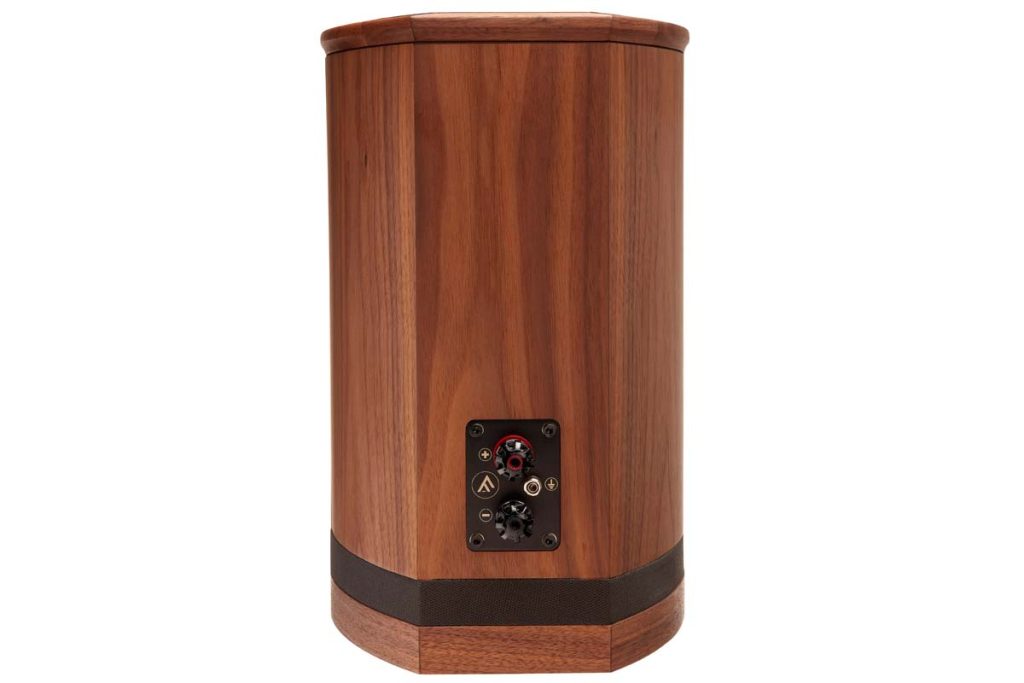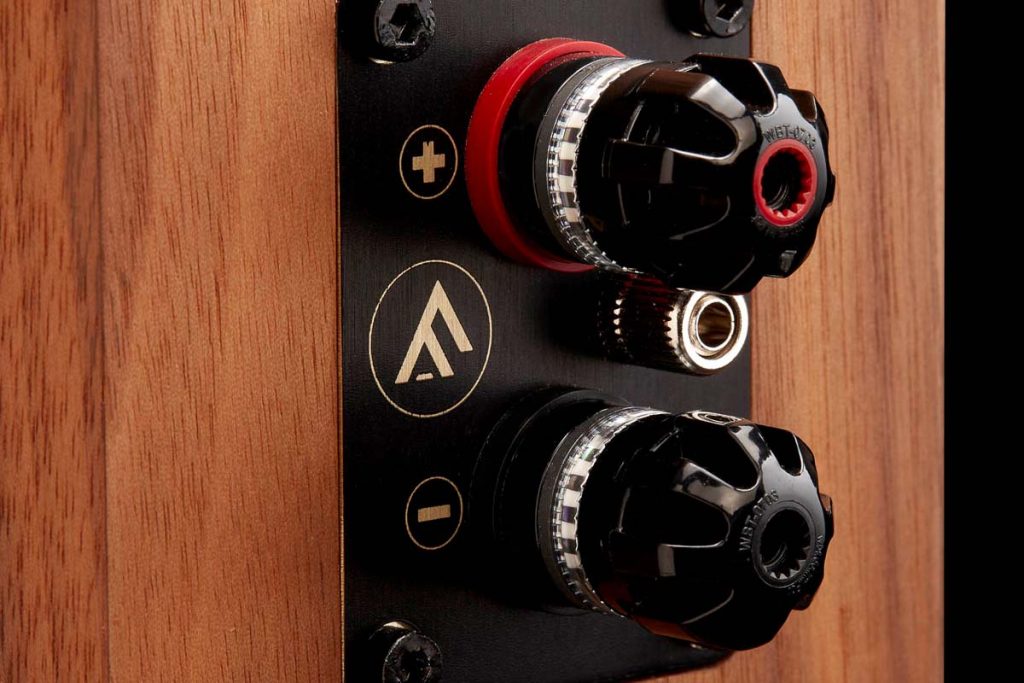Dr. Paul Mills had been developing loudspeakers for Tannoy for about a quarter century and has been doing the same job at Fyne Audio for several years now.
Consequently, the Scottish brand cannot hide the roots of its developer, neither visually nor technically. The latest addition to the Vintage series and the first compact speaker in the range is the Fyne Audio Vintage Five. The number five in the name, which describes the chassis radius, also evokes memories of the best British monitor speakers, even though Fyne Audio, of course, employs a coaxial driver. So, does this little Scot belong in the studio or in the living room?
The volume and dimensions already indicate this: The listening room for the Vintage Five need not and should not be particularly large. On the other hand, weighing in at a good six kilograms per speaker these go really easy on your back. I positioned the compact pair on stands at ear height and angled them slightly towards the listening position. Incidentally, there is also a thread in the base of the speaker for mounting on a suitable stand.
The bent birch plywood cabinet is finished with a walnut veneer. The magnetic front cover gives the speaker a slightly more modern look, if that’s what you prefer. Behind it is the coaxial driver called “IsoFlare”. The five-inch bass-midrange driver has a fiber-reinforced paper cone with an asymmetrically structured surround. This is designed to prevent discoloration and absorb kinetic energy and has also been given a name: FyneFlute technology. The tweeter, located in the center of the cone, is fitted with a titanium dome tweeter driven by a vented neodymium magnet. Its lower resonance frequency is below the crossover frequency of 1.9 kilohertz. The diaphragm does not break up until beyond the human hearing range and thus remains balanced. Both drivers are held in place by a stable die-cast aluminum chassis. The tweeter, which is slightly offset to the rear, sends its signals through a waveguide, which is also designed for an even frequency response.
As with Tannoy, each crossover in the Vintage series has also been given a cryogenic once-over at below minus 150 degrees. This is intended to minimize the tiniest material stresses in the components, the solder joints and the silver-plated copper cabling. In this case, however, I don’t have a non-cryogenized crossover at hand for comparison. All components of the crossover are wired point-to-point and mounted on a vibration-damping platform. The tweeter is gently faded out with a 1st order high-pass filter, while the woofer is cut off somewhat more steeply at 12 decibels/octave (2nd order). Overall, this indicates a high level of phase accuracy.
“Brothers In Arms” only really gets going after the long, flat intro with a gentle hi-hat and then the entire drum kit. A Dire Straits track that I always like to use for my first listening experiences with loudspeakers. Mark Knopfler’s voice sounds balanced, natural and is placed firmly in the stereo center. It is positioned a little way behind the front edge of the stage and is also easy to locate at this position. I’m listening at moderate volume. The bass is defined. I can clearly identify the notes played on John Illsley’s steel strings. Nothing is artificially thickened or diffusely passed through. Can I feel the physical energy of the recorded bass amplifier in my listening chair? Of course not! No bass thunderstorms can come from a cabinet volume of around 17 liters – but nobody expects that anyway. Nevertheless, the Vintage Five sounds quite complete. This changes a little as the volume decreases. Then, the adjective “slim” is entirely appropriate. However, the details in the treble range are still remarkably easy to follow. Knopfler’s tube amp is providing with a slight spaciousness, and I can also hear the background noise of the guitar amplifier. This subtle information makes for a very transparent sound and a subjectively three-dimensional representation of the recording.
The 87 decibel efficiency of the Fyne Audio Vintage Five makes operation with a good tube feasible, but in my listening sessions I also worked with a powerful transistor amplifier. The difference can be heard above all in the bass range. With the tube it is actually a little fuller in the lower mid-range and therefore more powerful in the subjective perception of the bass range. However, the bass is more defined, more precise and also crisper with a transistor power amplifier. Both work well, it’s a matter of taste. What’s interesting here is just how precisely the Vintage Five shows the characteristics of the connected amplifiers!
Frenchman Kavinski has captured considerably more “oomph” than the classic Dire Straits record on his 2022 album Reborn. The precision with which Fyne Audio traces the impulsive electronic bass lines has a clear studio quality. I could well imagine mixing a track on the five. “Renegade” is playing. The fundamentally different sound character of this recording compared to Dire Straits now comes into its own. I can clearly hear the slightly warm, electronic character. This is mainly due to the good and clear representation of voices. The vocals always emerge from the instrumental foundation just a little behind the connecting line between the two loudspeakers, no matter how complex it may be.
I would like to try out the well-designed and tactile Presence control on the front panel. Here you can raise or lower the frequency range between 2.5 and 5 kilohertz by a maximum of 3 decibels. Completely analog, of course. This makes it possible to adapt to different room acoustics to a certain extent. The changes are particularly audible with acoustic instruments and small ensembles. A useful feature. Another feature is the earthing socket on the speaker terminal. I connect it to the ground terminal of the amplifier. Guitarist and singer John Mayer is once again allowed to sing “Wild Blue”. This record, which has a rather warm sound mix, convinces over the Vintage Five with the advantages already mentioned for both voice and guitar. Now I connect the earthing cables. The tonal balance shifts a little further downwards, in other words, the bass range benefits from this. The accuracy remains, but the foundation seems a little more stable. At the same time, the previously very wide stage becomes a little more compact and is oriented more towards the center of the stereo image. For my taste, this is the more complete version. However, these are still nuances.
Incidentally, if I position the loudspeaker slightly differently in the room, it makes virtually no difference to the bass response. In my opinion, this is due to the smart bass reflex system that Dr. Paul Mills and his team have come up with. The name “BassTrax” describes a system that radiates downwards from the cabinet and then all the way around, which is designed to distribute the bass energy as homogeneously as possible in the room. As the base plate, and therefore the distance to the actual reflex port, is fixed and no tube “blows” forwards or backwards, the Vintage Five is quite uncritical in terms of placement as far as the bass range is concerned. On the base plate there is an additional upward cone (Traktrix shape), which dissipates the bass energy to the outside without problematic reflections. It works!
Finally, Coleman Hawkins is allowed to take out his saxophone in the Van Gelder Studio. The balance between the main instrument, guitar, piano, bass and drums is perfect. The cymbals in particular are one of the compact Scot’s specialties. They shine without ever becoming dazzling – and once again the spatial layering is convincing. In the track “I’ll Never Be The Same”, Kenny Burrell takes over the sceptre on guitar a good halfway through, before Ronnell Bright lively introduces the piano into the musical dialog. Time to relax, listen and discover!
The Fyne Audio Vintage Five is a compact loudspeaker with high-quality craftsmanship and an open and spatial reproduction that tends towards a classic monitor loudspeaker. With small, clever details (earthing terminal, asymmetrical surround, Traktrix element in the bass reflex unit), the Fyne Audio Vintage Five remains true to its genes and yet brings a lot of independence to the table.
Accompanying Equipment
Turntable: Elac Miracord 70 with AT-PTG33/II, Rega Planar 3 | Phono preamplifier: Luxman E-250 | CD player/converter: Luxman D-N150, Audiolab 8200 CDQ | Preamplifier: Audiolab 8200 CDQ | Integrated amplifier: Luxman SQ-N150 | Power amplifier: Audiolab 8200 P | Speakers: Klipsch Heresy IV | Cables: Ecosse, Tara Labs, HMS, Furutech, Supra
Loudspeaker Fyne Audio Vintage Five
Concept: 2-way coaxial standmount loudspeaker with 360° bass reflex system | Sensitivity: 87 dB (2.83 V @ 1 m) | Impedance: 8 Ω | Frequency response (-6 dB in-room): 46 Hz to 38 kHz | Special features: IsoFlare coaxial drivers, presence control, BassTrax reflex system with Traktrix cone as diffuser, ground terminal on speaker terminal, cryogenized crossover | Inputs: one pair of speaker terminals each | Finish: walnut real wood veneer on birch multiplex cabinet | Dimensions (W/H/D): 22/35/26 cm | Weight: 6.2 kg | Pair price: around 4500 €
TAD Audiovertrieb
Rosenheimer Straße 33
83229 Aschau im Chiemgau
Phone +49 8052 9573273
hifi@tad-audiovertrieb.de








